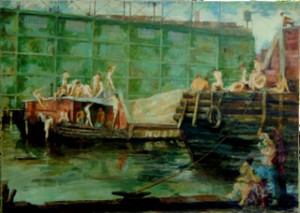Michael Insinna, his life and works
 “If you are to be an artist, you must first learn to draw and draw expressively.You must do this before you can paint. Only then will you be able to make yourself, your aims, and your thoughts fully understood”.
“If you are to be an artist, you must first learn to draw and draw expressively.You must do this before you can paint. Only then will you be able to make yourself, your aims, and your thoughts fully understood”.This is what Michael would tell his students at the Famous Artists School , in Westport Ct. in the 1960’s ,where he was one of the “Famous artist’s” stable of instructors.
Born in Passaic New Jersey, he was only a boy when he realized he wanted to be a painter and spent his entire life in the persuit and realization of that dream. He had his heart set on attending one of the most famous fine old art schools in the eastern USA, Cooper Union, in New York City. He was overjoyed when he’d been accepted, but almost immediately he had to face a serious problem. His family was in straitened circumstances, and he had to do his share to keep it afloat economically.
At night he attended classes at Cooper Union, and by day worked at a soda fountain, as a clerk, or did any job he could find.
“Getting my art education was a struggle”, he used to reminisce, ” I had to fight for it all the way!”
Finally he developed his skill to such a degree that he was awarded a scolarship at the Art Student’s League, Here he studied with Robert Brackman, the noted portrait painter, among many other famous artists.
But the United States was already embroiled in WWII, and Michael was called into the army. When his military duties allowed, he worked at his art, and with the end of the war, he was able to resume his studies at the Art Students League. Brackmans teaching again brought enrichment; Michael learned much, too, from William Zorach, the famed sculptor, and Ivan Olinsky, the portraitist. He was already selling portraits.
A good artist can make a good teacher. After completeing his formal art training, Michael was offered a teaching job with the Franklin School of Professional Arts, in New York City.
He taught anatomy, drawing, and painting-and every spare moment, he painted!
He went on to the Museum of Natural History , where he worked as an artist for the paleontology dept., where he studied and drew fossils–dinosaurs, fish, and other ancient life forms–which were used in museum publications- and he did illustrations for Natural History Magazine. He illustrated the popular book, Dinosaur Hunt, by George Whitaker and Joan Meyers
Soon his work was being exhibited at the National Achademy of Design, The Carnegie International Show in Pittsburg, PA, by personal invitation from Homer Gaudens. And also at various shows and galleries in New York and New Jersey.
I would like to take this opportunity to show and share some of Michael’s work with the world.
I feel his art and his paintings were very indicative of the New York art scene of the 1940’s and also the whole Art Students League approach to art.
He followed in the footsteps of Robert Henri, and drew his inspiration from the everyday scenes, and from portraiture of all kinds.
He drew and painted scenes from the city streets, and then went on to paint the wonderful and colorful scenes and people of Mexico, which continued to be a source of inspiration all of his life.
For more on Michael, his wonderful works, and a short video of photographs of the artist and his life, see his Squidoo Lens here,
For info on Michael’s paintings that are available for purchase, please contact me.
Thanks for reading this,
Sincerely,
Gemma
gemmainsinna@libero.it




